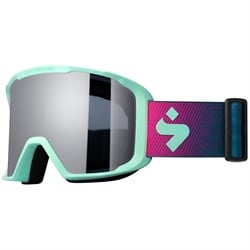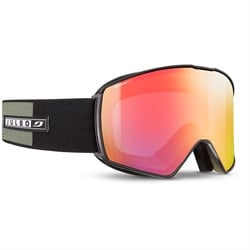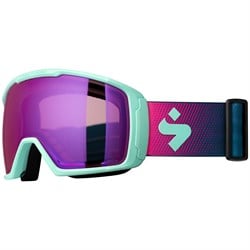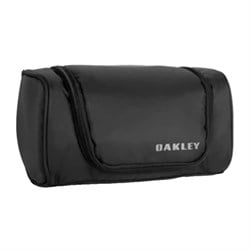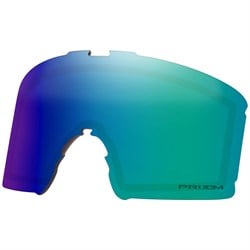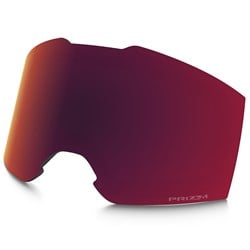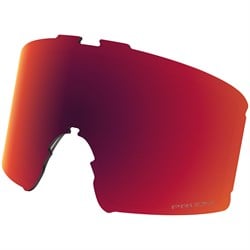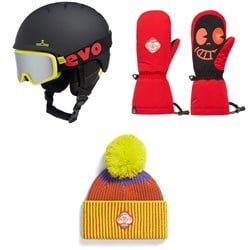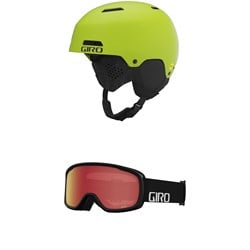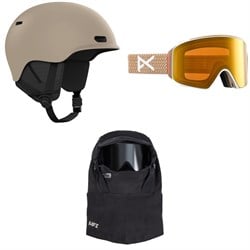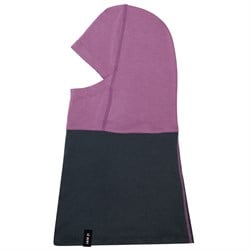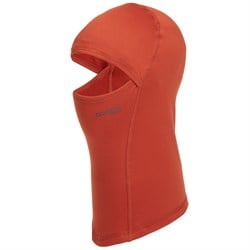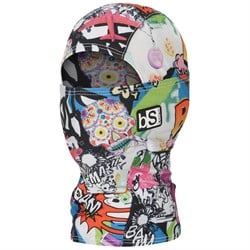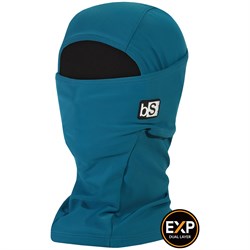How to Keep Your Goggles From Fogging
Goggle fog got ya down? This common phenomenon plagues riders everywhere. Besides the obvious frustrations of losing your sight, goggle fog can be dangerous if you're navigating treacherous terrain. Keeping your vision clear can mean the difference between a super fun day exploring the mountains or a super challenging one. Luckily, we know many anti-fog tips and tricks to keep your goggles fog-free and crystal clear with the stoke at an all-time high.
What Is Goggle Fog?
Goggle fog is condensation, or small micro-droplets of water formed by the convergence of hot and cold air. Your body emits hot air as you sweat and move, while the snowy climate around you circulates colder air. When the two meet, warm, moist air rapidly cools, causing tiny drops of water to appear on the inner lens of your goggles. This phenomenon happens to us all, unless we create the right conditions for moisture to escape.Goggle fog appears when the moisture around your face cannot escape or evaporate. That’s why breathability is so important in outdoor gear. With proper ventilation, hot and cold air can move freely to wick away moisture from your body and allow it to escape before it condenses.
How to Prevent Foggy Goggles
Cold weather outerwear has a lot of moving parts so many different things could cause your goggles to fog. It's tough to improve the situation once your goggles have started fogging, so it's best to prevent it from happening in the first place. Luckily, this can usually be achieved with a few minor changes and adjustments to your gear.
Here are some common strategies to keep your goggles from fogging.
Goggle Tech
Your first line of defense against fogging issues is a good pair of ski/snowboard goggles. Goggles at most price points now include tech to combat fog, like anti-fog coatings, ventilation, and breathable face foam.Choose a Quality Pair of Goggles
Many goggles feature double-layer lenses (aka dual lenses) with an anti-fog coating on the inside. These lenses act like a dual-pane window. Sandwiched together, they create a thermal barrier that reduces fogging significantly. Double lenses are common, if not standard, on all new ski and snowboard goggles.Anti-fog coatings are different from the hydrophobic outer coatings that you can squeegee with that fancy goggle wipe on your gloves. Instead of repelling moisture, they absorb it. Although some coatings are more durable than others, all of them are easily damaged by contact with fabric or fingers. For this reason, and as we mentioned earlier, it is strongly recommended that you DO NOT wipe the inside of your goggles, even when you’re experiencing fog.
Ventilation is also an important anti-fog variable. Vents located on the top or bottom of goggles, between the lens and the protective face foam, allow air to circulate freely. Warm air from your face can exit up and into your helmet, where it escapes through helmet vents into the air. The face foam used on ski/snowboard goggles is great, allowing subtle breathability and wicking to pull moisture away from your face and help regulate temperature.
Keep a Spare Lens On-Hand
What’s the easiest way to combat fog? Swap them out for your backup pair, or switch out the lens and try again. Besides directly eliminating the fog, alternative lenses have the added benefit of giving you options for changing light. One lens might offer excellent visibility in the sun but not allow you to see the contours of the snow when it's cloudy. Plus, some goggles feature magnetic and quick-change lens systems, which are easy to use on the fly. The lenses pop on and off with a tab or magnets and are easy to store in a jacket pocket.There’s no denying that keeping a spare pair lens nearby is the fastest way to recover clear sight after you're experiencing significant fog.
Goggle Care
It’s extremely important to resist wiping the inner lens of your goggles when they're dirty, filled with snow, or already foggy. Wiping the inside of your lens will scratch or smudge the protective anti-fog coating and make your goggles more susceptible to fogging in the future. It’s just like defrost mode in your car. Fingerprints on the windshield = bad. To keep your lenses in optimal condition, the best thing to do is to allow the inner lens to dry out naturally. Always use a clean microfiber towel if you must wipe any part of your goggles.Post-Ride Drying and Storage
Stuffing wet/snowy goggles in a backpack or duffle bag and hoping that they'll be dry by the next time you unearth them is a recipe for fogging. Instead, always store your goggles in a warm, dry place when not in use, and make sure they’ve thoroughly dried out before putting them back in their microfiber storage case. Leftover moisture isn't good for the longevity of your gear and will also smell and feel gross the next time you ride.When it comes to drying out your goggles, it is also discouraged to place them directly over a heat vent, hold them too close to a blow dryer, or hang them particularly close to a fireplace. High degrees of heat can be detrimental to the anti-fog treatment.
Avoid Keeping Goggles on Your Helmet Too Long
Putting your goggles on your helmet for long periods exposes your goggles' inner lens to cold air, making them more prone to fogging once you put them back on your face to start riding again. If you must put them up on your forehead, try to keep it short and sweet unless you’re in the lodge.
Breathability & Ventilation
Shedding excess layers is the easiest way to prevent goggle fogging without changing any of the gear you already own. Unzipping vents or taking off your balaclava can help prevent overheating, which may be enough to balance the temperature differential and eliminate your foggy goggle issues. Improving airflow between your body and your gear is crucial to your overall experience and the state of your goggles.Keep Clear Vents of Snow
Yeah, getting faceshots in blower pow is great, but so is taking a breather afterward to knock snow out of the nooks and crannies. Left unchecked, that blower pow caked around your goggles will melt and seep into the foam, eventually causing some serious goggle fog.If de-clogging your vents to prevent fog isn’t enough motivation, think about the feeling of cold, moist drips of snow melting directly into your face...
Pair With a Well Ventilated Helmet
Vents are standard on most ski and snowboard helmets and help increase airflow from goggles. Pairing your goggles with a well-ventilated helmet can help keep air moving away from your face and out of your gogs. Not only that, many companies design their helmet and goggle vents to line up seamlessly, working in tandem to pull warm, moist air away from your goggles. If you want the best possible ventilation, pairing your goggles with a helmet from the same manufacturer can boost performance.You might also benefit from a helmet with a visor, as it directs the snow away from the vents in your goggles. Remember, snowy goggles are the enemy!
Use a Goggle Compatible Balaclava
There should be no overlap between the foam in your goggles and the seams of your balaclava. While it might seem counterintuitive to put goggles on your bare face during a storm cycle, face foam creates an insulating layer that prevents fogging while still keeping you warm. Brands like Anon even make magnetic facemasks that clip onto the nose-bridge of the goggles to ensure the perfect fit.It’s also vital that you find a breathable balaclava. When the fabric around your mouth starts to feel soggy, that means your balaclava is probably holding moisture from breathing. Again, this can cause excess moisture in the system, which leads to fog. Some have dedicated mouth or nose holes or are shaped like a tube so they can be custom configured and worn in a way that best suits your setup.
Goggle Fit
Find a pair of goggles that fit snugly to the shape of your face. The "gaper gap" isn’t just a fashion faux pas. Gaps between your goggles and helmet allow cold air and moisture in, creating a temperature differential, which causes fog. Eliminating the gap between your helmet and your goggles streamlines your system. Air can flow from your goggles to your helmet and out into the air without introducing extra cold air that causes fog. Various frame sizes are available, including Over-the-Glasses or OTG frames which are designed to fit over prescription glasses, and Low Bridge Fit for people with flatter facial features.Last Resort: Apply an Anti-Fog Coating
If you’re trying to reduce waste or save money by not purchasing new goggles, and/or all else has failed, it’s possible to reapply an anti-fog treatment to the inside of your goggles. Check with your goggle manufacturer for more details.Learn More With Our Other Accessories Guides:
- Sunglasses - How to Choose
- Sunglasses - Style & Face Shape
- Goggles - How to Choose
- Goggles - How to Wear Goggles with Glasses
- Goggles - How to Prevent Fogging
- Helmets - How to Choose & Fit Guide
- Helmets - MIPS Technology
- Gloves & Mittens - How to Choose
- Hats - Types, Styles, & Materials
- Socks - How to Choose Ski & Snowboard Socks
Discover Our Favorite Accessories:
- The Warmest Mittens
- The Best Face Masks, Neck Tubes & Balaclavas
- The Best Ski & Snowboard Mittens
- The Best Ski & Snowboard Helmets
- The Best Kids' Ski & Snowboard Helmets
- The Best Ski & Snowboard Socks
- The Best Ski & Snowboard Gloves
- The Best Kids' Ski & Snowboard Gloves
- The Best Ski & Snowboard Goggles
- The Best Kids' Ski & Snowboard Goggles
- The Best Value Ski & Snowboard Goggles
- The Best Ski Bags
- The Best Ski & Snowboard Boot Bags
- The Best Ski & Snowboard Backpacks
- The Best Snowboard Bags
- The Best Ski & Snowboard Wax
- The Best Snowboard Stomp Pads
- The Best Ski & Snowboard Glove Liners
- The Best Snowboard Wrist Guards & Protective Gear
- The Best Heated Ski Socks & Ski Boot Heaters
- The Best Beanies

